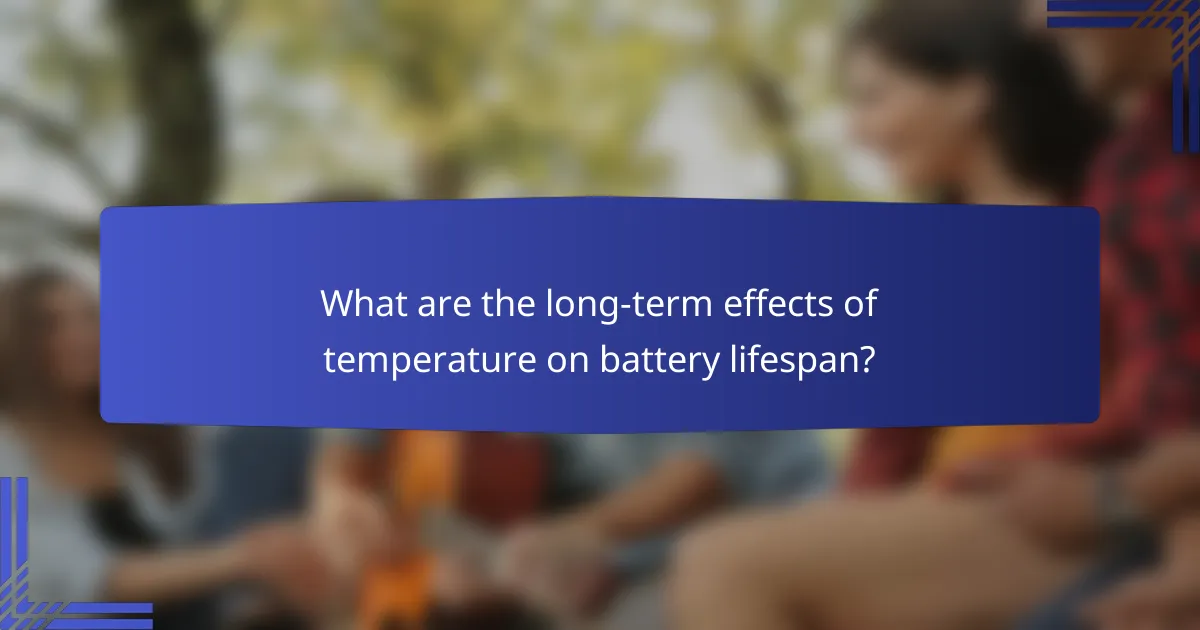Temperature plays a crucial role in the performance and efficiency of cordless tool batteries, directly influencing their capacity and lifespan. Extreme heat or cold can hinder battery functionality, making it vital for users to adopt best practices for managing these conditions. By understanding the specific characteristics of different battery types, such as lithium-ion and nickel-metal hydride, users can optimize their tools for varying environmental challenges.

How does temperature affect cordless tool battery performance?
Temperature significantly impacts cordless tool battery performance, affecting both efficiency and lifespan. Extreme temperatures can lead to reduced capacity and performance, making it essential to understand how to manage these conditions for optimal use.
Battery efficiency decreases in extreme heat
High temperatures can cause a cordless tool battery to operate less efficiently. When exposed to extreme heat, the chemical reactions within the battery accelerate, leading to increased internal resistance and potential overheating.
This can result in a shorter runtime and may even damage the battery over time. Users should avoid leaving batteries in hot environments, such as inside vehicles or direct sunlight, to maintain their efficiency.
Cold temperatures reduce battery capacity
Cold weather negatively affects the capacity of cordless tool batteries, often leading to diminished performance. At low temperatures, the chemical reactions slow down, resulting in reduced voltage and capacity.
In practical terms, this means that a battery may only deliver a fraction of its normal power when used in cold conditions. To mitigate this, users can store batteries indoors at room temperature and allow them to warm up before use in cold environments.
Optimal operating temperature range
The optimal operating temperature range for most cordless tool batteries is typically between 10°C and 30°C (50°F to 86°F). Within this range, batteries perform at their best, providing maximum efficiency and longevity.
To ensure peak performance, users should aim to keep batteries within this temperature range during both storage and operation. Regularly checking the temperature of the battery can help prevent issues related to extreme heat or cold.

What are the best practices for using cordless tools in varying temperatures?
To ensure optimal performance and longevity of cordless tool batteries in varying temperatures, it’s essential to follow specific best practices. These practices help maintain battery efficiency and prevent damage caused by extreme heat or cold.
Store batteries in temperature-controlled environments
Storing batteries in a temperature-controlled environment is crucial for maintaining their health. Ideally, batteries should be kept in a range of 15°C to 25°C (59°F to 77°F) to prevent degradation. Extreme temperatures can lead to reduced capacity and lifespan.
When storing for extended periods, avoid locations like attics or basements where temperatures fluctuate significantly. Instead, consider a climate-controlled space to ensure consistent conditions.
Precondition batteries before use
Preconditioning batteries before use can significantly enhance their performance in extreme temperatures. If a battery has been stored in a cold environment, allow it to warm up to room temperature for at least an hour before use. This practice helps to improve chemical reactions within the battery.
Conversely, if a battery has been exposed to high temperatures, let it cool down to a safe operating temperature before charging or using it. This can prevent overheating and potential damage during operation.
Use thermal insulation for batteries
Using thermal insulation for batteries can protect them from temperature extremes during operation. Insulated battery cases or wraps can help maintain a stable temperature, especially in very hot or cold conditions. This is particularly useful for outdoor work in fluctuating climates.
Consider investing in insulated bags or pouches designed for battery storage and transport. These can provide an extra layer of protection and help maintain optimal battery performance, ensuring your tools operate effectively regardless of the weather.

Which cordless tool batteries perform best in extreme temperatures?
Cordless tool batteries vary significantly in performance under extreme temperatures, with lithium-ion (Li-ion) batteries generally excelling in cold conditions and nickel-metal hydride (NiMH) batteries better suited for high heat. Understanding these characteristics can help users select the right battery for their specific environmental challenges.
Li-ion batteries for cold weather
Li-ion batteries are known for their ability to operate effectively in cold temperatures, often down to -20°C (-4°F). They maintain higher energy density and discharge rates compared to other battery types, making them ideal for outdoor work in winter conditions.
However, users should be aware that while Li-ion batteries perform better in the cold, their overall capacity can still diminish. To maximize performance, keep batteries warm before use, such as storing them in insulated bags or near body heat when not in use.
NiMH batteries for heat resistance
NiMH batteries typically handle high temperatures better than Li-ion batteries, making them suitable for hot environments, often tolerating temperatures above 40°C (104°F). They are less prone to overheating and can sustain performance during prolonged use in heat.
Despite their heat resistance, NiMH batteries have a lower energy density and may discharge more quickly than Li-ion counterparts. Users should consider this trade-off when selecting batteries for tools used in extreme heat, ensuring they have enough capacity for their tasks.
Brand comparisons: DeWalt vs. Milwaukee
When comparing DeWalt and Milwaukee cordless tool batteries, both brands offer robust options for extreme temperatures but with distinct characteristics. DeWalt’s Li-ion batteries are known for their cold weather performance, while Milwaukee’s batteries often excel in heat resistance, particularly their high-output models.
Users should evaluate specific battery models based on their typical working conditions. For cold environments, DeWalt’s FlexVolt series may provide an edge, while Milwaukee’s REDLITHIUM technology is designed to withstand higher temperatures effectively. Consider the specific tools and tasks to make an informed choice between these two leading brands.

How can users adapt their cordless tools for temperature fluctuations?
Users can adapt their cordless tools for temperature fluctuations by implementing strategies that enhance battery performance and longevity. This includes utilizing battery management systems, monitoring temperature, and adjusting tool settings based on environmental conditions.
Use battery management systems
Battery management systems (BMS) are essential for optimizing the performance of cordless tool batteries in varying temperatures. A BMS can monitor battery health, charge cycles, and temperature, ensuring that the battery operates within safe limits. This can prevent overheating and extend battery life.
When selecting a cordless tool, look for models equipped with advanced BMS features. These systems often include thermal protection and automatic shut-off mechanisms that activate when temperatures exceed safe thresholds, which is particularly useful in extreme weather conditions.
Implement temperature monitoring solutions
Temperature monitoring solutions can help users keep track of battery conditions in real-time. Using external temperature sensors or built-in indicators on the tool can provide valuable insights into how temperature affects battery performance. This allows users to take proactive measures before issues arise.
For example, if a battery is operating in a high-temperature environment, users can take breaks to allow the tool to cool down, preventing potential damage. Additionally, some smart tools offer apps that alert users when temperatures reach critical levels, enabling timely interventions.
Adjust tool settings for temperature
Adjusting tool settings based on temperature can significantly improve efficiency and performance. Many cordless tools have adjustable power settings that can be modified according to the ambient temperature. For instance, using lower power settings in extreme heat can reduce strain on the battery.
Users should also consider the material they are working with, as different materials may require different power levels. In colder temperatures, tools may need to be warmed up before use to ensure optimal performance, while in hot conditions, reducing the workload can help maintain battery health.

What are the signs of battery failure due to temperature?
Signs of battery failure due to temperature include rapid discharge, physical swelling, and inconsistent charging behavior. These indicators can help users identify when a battery is struggling due to extreme heat or cold, allowing for timely intervention or replacement.
Rapid discharge during use
Rapid discharge occurs when a battery loses its charge much faster than expected during operation. This can be particularly noticeable in extreme temperatures, where batteries may only last a fraction of their normal runtime. For instance, a battery that typically powers a tool for several hours may only last for a few minutes in very cold or hot conditions.
To mitigate this issue, users should monitor battery performance regularly and avoid using tools in extreme temperatures whenever possible. If rapid discharge is observed, consider replacing the battery or storing it in a more temperature-stable environment.
Physical swelling or damage
Physical swelling or damage is a critical sign of battery failure, often caused by overheating. When batteries are exposed to high temperatures, the internal components can expand, leading to visible bulging or even leakage. This not only affects performance but can also pose safety hazards.
If you notice swelling, it is essential to stop using the battery immediately and dispose of it according to local regulations. Avoid attempting to charge or use a swollen battery, as this can lead to further damage or potential hazards.
Inconsistent charging behavior
Inconsistent charging behavior refers to a battery that does not charge reliably or takes an unusually long time to reach full capacity. This can be exacerbated by temperature extremes, which can affect the chemical reactions within the battery. For example, a battery that normally charges in a couple of hours may take significantly longer in cold weather.
To address this, ensure that batteries are charged in a temperature-controlled environment. If inconsistent charging persists, it may be time to replace the battery, especially if it is showing other signs of failure.

What are the long-term effects of temperature on battery lifespan?
Temperature significantly impacts battery lifespan, with extreme heat and cold leading to accelerated degradation. Maintaining batteries within optimal temperature ranges is crucial for maximizing their performance and longevity.
Increased degradation rates in high heat
High temperatures can cause chemical reactions within the battery to accelerate, leading to faster degradation. For lithium-ion batteries, operating above 30°C (86°F) can shorten their lifespan by as much as 20-30% over time.
To mitigate heat-related damage, avoid leaving batteries in direct sunlight or inside hot vehicles. Regularly check for signs of swelling or leakage, which can indicate overheating and potential failure.
Reduced cycle life in cold conditions
Cold temperatures can hinder battery performance by slowing down the chemical reactions necessary for energy production. When exposed to temperatures below 0°C (32°F), lithium-ion batteries may experience a significant reduction in available capacity and cycle life.
To protect batteries in cold weather, store them in a warmer environment when not in use and allow them to reach room temperature before charging. Avoid using tools in extreme cold to prevent unnecessary strain on the battery.
